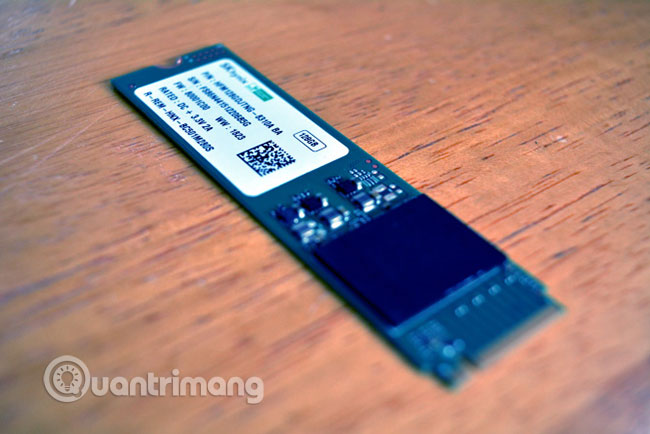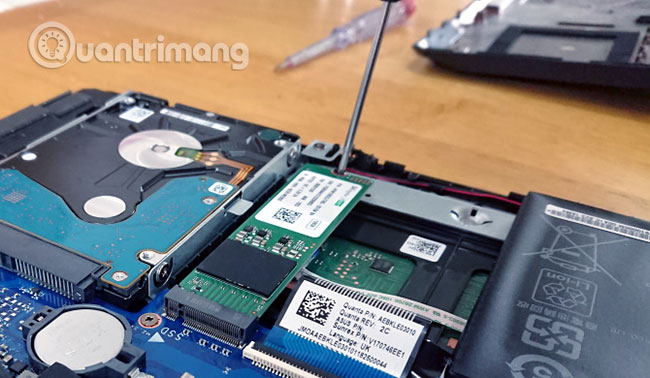What is SSD M.2?
Whether you are building a PC or just want a fast drive to run your operating system, you should consider using an SSD. But instead of choosing a normal 2.5 inch SATA device, why not consider a slightly newer option?
SSD has been developed, with released devices that can plug directly into the motherboard. You may have heard about mSATA, but what is SSD M.2? And how do you install an M.2 SSD in your PC? Find TipsMake.com for answers via the following article!
Pros and cons and how to install the M.2 SSD drive
- SSD M.2 or mSATA SSD?
- What does SSD M.2 look like?
- How to install the M.2 SSD
- Disadvantages of using SSD M.2
SSD M.2 or mSATA SSD?
When building your own PC or upgrading an existing model, using the fastest storage option can be a smart step. After all, if you can install your operating system on super-fast storage devices, your computer will run faster.

M.2, formerly known as the Next Generation Form Factor (NGFF), provides faster data throughput than standard mSATA. Because mSATA is dependent on PCIe, it is limited to 6Gb per second (Gb / s). Windows tablets and old laptops use mSATA SSDs.
There are three types of M.2:
- SATA: This option uses AHCI driver and routes to SATA 3.0 port via M.2 connector. It is slow, but widely compatible with many devices.
- AHCI: Advanced Host Controller Interface is a slower option found on cheap and suitable motherboards for older operating systems. SSDs are connected via AHCI, often acting more like DRAM than standard HDD drives.
- NVMe: Non-Volatile Memory Express or NVM Express is created specifically for the next generation SSD. Although NVMe is available with standard PCIe connections for desktop motherboards and form factors (the phrase refers to the size and shape of a particular desktop motherboard) M.2 uses a different connector. .
Although the mSATA SSD is great, take the opportunity to use M.2 if your motherboard supports it.
What does SSD M.2 look like?
You will find some differences in the connectors. The important thing is that you have to buy the right type of M.2 SSD for connecting on your motherboard. There are three configurations, different based on the position of the notch (distance in the edge connector).
- B : Notch has a distance of 6 batteries (pins) from the left.
- M : Notch has a distance of 5 batteries from the right.
- B&M: There are two notch. The first notch has a distance of 6 pin from the left, the second notch has a distance of 5 pin from the right.
Obviously, you will need to carefully check your motherboard documentation before purchasing the SSD M.2. Buying the wrong drive will cost you a lot of money!
How to install the M.2 SSD

Before you install the SSD M.2 drive, take the necessary antistatic measures. Be sure to disconnect the computer from the power source. If you install an SSD M.2 device in the laptop, remove its battery.
For detailed installation, please refer to the article: How to install SSD hard drive NVMe M.2?
Disadvantages of using SSD M.2
Although SSD M.2 can provide a super-fast operating system to the PC, you should be aware of the potential disadvantages of this drive.
For example, old motherboards, which support SSD M.2, can rely on PCIe bus. This means that devices are limited to 6Gb / s transfer rate. Furthermore, SSD M.2 drives connected to the PCIe bus cannot be used as the system's main drive.
New motherboards have no problems, so check if your hardware delivers the speed you expect.
Meanwhile, restrictions on motherboard design can limit how the M.2 device interacts with the rest of the system. PCIe bandwidth is limited. That means adding SSD M.2 can interfere with other hardware. Again, check the motherboard documentation to see how the M.2 drive may affect your settings.
Following these steps will allow you to install SSD M.2 into your PC or upgrade the existing M.2 device in your laptop. Either way, with faster storage devices installed, your operating system will boot faster and performance is also improved.

Just choose the right SSD M.2 and the connector for your motherboard. Consider an adapter if what you want exceeds the existing budget and note the device installation carefully.
Without the M.2 option on your motherboard, a standard SSD will still improve speed compared to traditional hard drives, as well as adding more RAM to the system. If you're new to SSDs, check out the article: 7 Mistakes to easily 'kill' an SSD to help extend the life of your SSD and the best SSD for Windows computers to have a few suggestions.
Wish you find yourself the right choice!
 Fix computer error not starting
Fix computer error not starting 16 connection ports are commonly found on computers and their functions
16 connection ports are commonly found on computers and their functions 7 things you need to know about discrete GPUs
7 things you need to know about discrete GPUs Top best 4K gaming monitors at all prices
Top best 4K gaming monitors at all prices Instructions for overclocking graphics cards for better gaming performance
Instructions for overclocking graphics cards for better gaming performance These factors determine the speed of the computer
These factors determine the speed of the computer